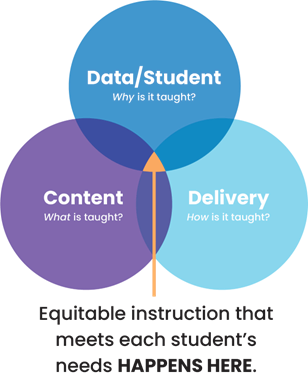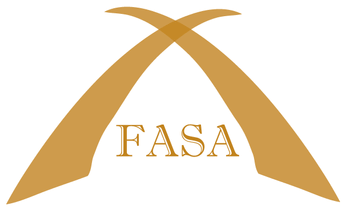A lifelong ladder: The power of effective literacy instruction
By: Dr. Liz Brooke, CCC-SLP
Is the curriculum we’re using to teach students to read working? The data tells us it is not. While 95% percent of students have the capacity to learn to read (when using programs based on the science of reading), only about 34% of fourth and eighth grade students read proficiently.
That’s a big gap, and a worrying one. As much as 85% of public school curriculum in the United States is delivered via reading, so a literacy curriculum that fails to deliver proficiency is failing students, period.
Given the gap between students’ capacity and their proficiency, it’s no wonder educational equity is such a priority goal for schools and districts. Academic success, personal empowerment, greater economic opportunities, and active civic participation are all literacy benefits that expand opportunities for students to develop their full academic and societal potential.
Equality vs. equity

It’s important to clarify upfront the difference between equality and equity in education. Equality is the leveling of the playing field, so every student gets the exact same resources
and support. Equity, on the other hand, means each student receives personalized learning geared to their particular needs so that every student has the same opportunity to succeed.
Meeting each student where they are and providing individualized instruction is the most equitable approach to literacy. But that can be a lot to ask of already overloaded teachers.
By applying the body of research about how children learn to read, and by using educational technology tools that deliver supplementary instruction attuned to the student’s needs, lessons can be personalized to each student's skill level.
Let’s look at how effective literacy instruction can advance equity.
Curriculum based in the science of reading
A high-quality literacy curriculum advances literacy achievement. However, not all teachers are familiar with the decades of research about how to best teach reading, known as the science of reading, and the application of that research for instruction, which is Structured Literacy.
A helpful framework for thinking about reading instruction that is informed by the science of reading is the Simple View of Reading, a formula originally presented by Gough and Tunmer. This framework proposes that reading comprehension is the product of decoding and language comprehension. Decoding is the ability to translate print into its spoken equivalents. Language comprehension is the ability to derive meaning from text through listening.

When selecting edtech to supplement teacher-led instruction, it’s important to identify programs that are research-proven to improve learning outcomes, not just research-based. All quality literacy programs should cover each of these component areas:
- Phonology, the sound system of language
- Orthography, the writing system of language
- Morphology, the meaningful units of words (prefixes, roots, suffixes, and combining forms), called morphemes
- Semantics, the meanings of words and the relationships among words
- Pragmatics, the rules of conversation (e.g., eye contact, taking turns) and the
use and interpretation of language in a particular context
- Syntax, the order and relationships of words in oral and written sentences, along with the structure of sentences in oral and written language
- Discourse, the organization of spoken and written communication
Teachers who are highly knowledgeable about Structured Literacy know why they teach these components, based on student data, know what exactly they need to teach, and know how to teach the components using the principles of Structured Literacy (e.g., explicit, systematic, etc.).

Performance-based assessment
In addition to traditional, standardized assessments that can target instructional needs in foundational skills and measure progress in these skills, the Department of Education’s “Every Student Succeeds Act” (ESSA) recommends the addition of performance-based assessments. These measure what standardized multiple-choice assessments cannot: how students use or apply the knowledge they acquire through the completion of a task.
Teachers benefit from on-demand student progress data that can answer questions like:
- Which of my students are on track for success?
- How much progress are my students making?
- What is the profile of skills for my student?
- Where do I need to focus my intervention?
- Have my students learned the material that has been taught?
Armed with this insight, teachers can meet the unique instructional needs of a diverse body of students. One of the easiest ways to get this data is by supplementing teacher instructional time with a blended learning program that offers individualized learning paths and embedded assessment.
A blended learning approach can provide personalized literacy instruction by identifying learner skill levels in each of the areas of reading and delivering instruction accordingly. This provides teachers with real-time performance data for each student—where they are doing well and where they might be struggling.
If schools are looking to edtech for support, they should opt for programs that offer individualized instruction, a blended learning structure, on-demand student progress data, and teacher support. This support for educators should include actionable next step recommendations based on student performance data, and instructional resources for small-group and individual activities in the classroom.
Equitable education
How do a high-quality curriculum and performance-based assessment ensure all students receive adequate, equitable resources?
By identifying the strengths, a student brings to literacy learning and creating plans to address any learning needs. With this understanding, school leadership is equipped to:
- Align district and school initiatives
- Gauge the effectiveness of literacy instruction
- Plan professional learning opportunities
- Invest in research-proven edtech
- Allocate resources
With the additional knowledge and tools, teachers are better equipped to match their instruction to a student’s needs, as well as identify the intensity of instruction required to help the student progress. This ensures the instructional curriculum, resources, and practices are not based on personal preference or personal beliefs, but are based on data, need, and scientific evidence.
As teachers translate student needs into instruction, it’s important to consider:
Goals and objectives: Does the student understand the purpose for learning the skills and strategies taught? Does the teacher have assessment data to guide the setting of the goals?
Appropriate pacing: Does the pace allow for frequent student response and maximize instructional time?
An instructional routine: Are the instructional formats consistent from lesson to lesson so students can focus their cognitive energy on learning the new skill?
Literacy leads to equity
Literacy—the ability to read, write, and communicate productively—is essential to academic success, which in turn provides equitable opportunities for each student.
Empowering teachers with the knowledge and educational technology tools they need to deliver an equitable, Structured Literacy curriculum will help all students reach their potential and help close the gap between student capability and proficiency. Learn more about how to incorporate Structured Literacy instruction in the classroom with this education insight.
Dr. Liz Brooke Bio:
Dr. Liz Brooke is the Chief Learning Officer of Lexia Learning. As Chief Learning Officer, Liz is responsible for setting the educational vision for the company’s Language and Literacy products, including the Adaptive Blended Learning (ABL) strategy. She has been with the company for over 10 years. Prior to joining Lexia, Liz served as the Director of Intervention at the Florida Center for Reading Research (FCRR). She has been working in education for over 25 years. She has worked in hospital, university, and school settings as a speech-language pathologist, researcher and began her career as a first-grade teacher. She has been published in several scholarly journals and books. Liz shares Lexia’s mission of changing lives through the power of language and literacy education and it continues to be the driving force behind all of her work.
Lexia Learning has solutions for every Florida learner! Click Here to contact one of our experts and continue the conversation!
